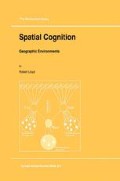Abstract
The purpose of this chapter is to consider the nature of cognitive maps. The need to simplify a complex world has caused researchers to produced a number of classification schemes for spatial information. If we consider a cognitive map the knowledge we have learned about an environment that is stored in our memory, a number of immediate questions arise. What does it mean to learn? How is the knowledge stored? Are there different types of memory? Are there different types of spatial knowledge? Given that the human brain has approximately 100 billion neurons that are connected in a network to process information (McNaulton and Nadel 1990), and following a wet mind approach (Kosslyn and Koenig 1992), a simple definition of a cognitive map for a particular chunk of geographic space would be those neurons and connections that represent information about that chunk of geographic space. For example, Figure 3.1 shows part of a hypothetical neural network for landmarks in a city and some of their characteristics. One pool of neurons represents urban landmarks and others represent characteristics or a list of names (McClelland and Rumelhart 1989). One could access knowledge related to a particular landmark by thinking of its name. For example, turning on Capitol from the name list connects through the object pool to the color brown, the size Small, the category Building, and the location North. Thinking of a category of landmarks allows you to access specific examples. For example, turning on Parks from the category pool connects through the object pool to Finlay Park. It would also connect to all other parks that were encoded as objects in the person’s neural network. Since the neurons and connections in the network were created through the person’s experiences with the urban environment, they reflect those experiences. Different parts of this cognitive map as neural network might have been encoded at different times using different encoding processes and much of the information has been abstracted. Particular views of cognitive maps can be illustrated by considering differences in encoding processes for the various types of spatial information discussed in the literature, internal structures that organize and store the information, and distortions that occur when information is decoded and used to make judgments for decisions.
Access this chapter
Tax calculation will be finalised at checkout
Purchases are for personal use only
Preview
Unable to display preview. Download preview PDF.
Author information
Authors and Affiliations
Rights and permissions
Copyright information
© 1997 Springer Science+Business Media Dordrecht
About this chapter
Cite this chapter
Lloyd, R. (1997). Cognitive Maps. In: Spatial Cognition. GeoJournal Library, vol 39. Springer, Dordrecht. https://doi.org/10.1007/978-94-017-3044-0_3
Download citation
DOI: https://doi.org/10.1007/978-94-017-3044-0_3
Published:
Publisher Name: Springer, Dordrecht
Print ISBN: 978-90-481-4783-0
Online ISBN: 978-94-017-3044-0
eBook Packages: Springer Book Archive

